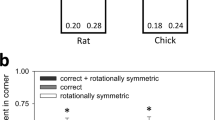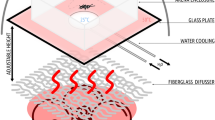Abstract
We report experiments based on a novel test in domestic chicks (Gallus gallus), designed to examine the encoding of two different geometric features of an enclosed environment: relative lengths of the walls and amplitude of the corners. Chicks were trained to search for a food reward located in one corner of a parallelogram-shaped enclosure. Between trials, chicks were passively disoriented and the enclosure was rotated, making reorientation possible only on the basis of the internal spatial structure of the enclosure. In order to reorient, chicks could rely on two sources of information: the relative lengths of the walls of the enclosure (associated to their left-right sense order) and the angles subtended by walls at corners. Chicks learned the task choosing equally often the reinforced corner and its rotational equivalent. Results of tests carried out in novel enclosures, the shapes of which were chosen ad hoc (1) to induce reorientation based only on the ratio of walls lengths plus sense (rectangular enclosure), or (2) to induce reorientation based only on corner angles (rhombus-shaped enclosure), suggested that chicks encoded both features of the environment. In a third test, in which chicks faced a conflict between these geometric features (mirror parallelogram-shaped enclosure), reorientation seemed to depend on the salience of corner angles. These results shed light on the elements of the environmental geometry which control spatial reorientation, and broaden the knowledge on the geometric representation of space in animals.




Similar content being viewed by others
References
Cheng K (1986) A purely geometric module in the rat's spatial representation. Cognition 23:149–178
Cheng K (1987) Rats use the geometry of surfaces for navigation. In: Ellen P, Thinus-Blanc C (eds) Cognitive processes and spatial orientation in animals and man. Martinus Nijhoff, Dordrecht, pp 153–159
Cheng K, Spetch ML (1998) Mechanisms of landmark use in mammals and birds. In: Healy S (ed) Spatial representation in animals. Oxford University Press, Oxford, pp 1–17
Gallistel CR (1990) The organization of learning. MIT Press, Cambridge, Mass.
Gouteux S, Thinus-Blanc C, Vauclair J (2001) Rhesus monkeys use geometric and nongeometric information during a reorientation task. J Exp Psychol Gen 130:505–519
Hermer L, Spelke ES (1994) A geometric process for spatial reorientation in young children. Nature 370:57–59
Hermer-Vasquez L, Spelke E, Katsnelson A (1999) Source of flexibility in human cognition: dual-task studies of space and language. Cogn Psychol 39:3–36
Kelly DM, Spetch ML (2001) Pigeons encode relative geometry. J Exp Psychol Anim Behav Process 27:417–422
Kelly DM, Spetch ML, Heth DC (1998) Pigeons' (Columbia livia) encoding of geometric and featural properties of the environment. J Comp Psychol 112:259–269
Learmonth AE, Nadel L, Newcombe NS (2002) Children's use of landmarks: implications for modularity theory. Psychol Sci 13:337–341
Margules J, Gallistel CR (1988) Heading in the rat: determination by environmental shape. Anim Learn Behav 16:404–410
Sovrano AV, Bisazza A, Vallortigara G (2002) Modularity and spatial reorientation in a simple mind: encoding of geometric and nongeometric properties of a spatial environment by fish. Cognition 85:B51–B59
Sovrano AV, Bisazza A, Vallortigara G (2003) Modularity as a fish views it: conjoining geometric and non-geometric information for spatial reorientation. J Exp Psychol Anim Behav Process 29:199–210
Tommasi L, Vallortigara G (2000) Searching for the centre: Spatial cognition in the domestic chick (Gallus gallus). J Exp Psychol Anim Behav Process 26:477–486
Tommasi L, Vallortigara G, Zanforlin M (1997) Young chickens learn to localize the centre of a spatial environment. J Comp Physiol A 180:567–572
Tommasi L, Andrew RJ, Vallortigara G (2000) Eye use in search is determined by the nature of task in the domestic chick (Gallus gallus). Behav Brain Res 112:119–126
Vallortigara G, Zanforlin M, Compostella S (1990a) Perceptual organization in animal learning: cues or objects? Ethology 85:89–102
Vallortigara G, Zanforlin M, Pasti G (1990b) Geometric modules in animals' spatial representations: a test with chicks (Gallus gallus domesticus). J Comp Psychol 104:248–254
Author information
Authors and Affiliations
Corresponding author
Rights and permissions
About this article
Cite this article
Tommasi, L., Polli, C. Representation of two geometric features of the environment in the domestic chick (Gallus gallus). Anim Cogn 7, 53–59 (2004). https://doi.org/10.1007/s10071-003-0182-y
Received:
Revised:
Accepted:
Published:
Issue Date:
DOI: https://doi.org/10.1007/s10071-003-0182-y




